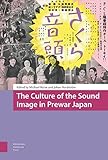The Culture of the Sound Image in Prewar Japan / ed. by Michael Raine, Johan Nordström.
Material type: TextPublisher: Amsterdam : Amsterdam University Press, [2020]Copyright date: ©2020Description: 1 online resource (224 p.)Content type:
TextPublisher: Amsterdam : Amsterdam University Press, [2020]Copyright date: ©2020Description: 1 online resource (224 p.)Content type: - 9789048525669
- Motion picture music -- Japan
- Motion pictures -- Japan -- History and criticism
- Sound in motion pictures
- Cultural Studies
- East Asia and North East Asia
- Film Studies
- Film, Media, and Communication
- Radio and Television
- HISTORY / Asia / Japan
- Media history, transition to sound, cultural history, sound culture
- 791.430952 23
- online - DeGruyter
| Item type | Current library | Call number | URL | Status | Notes | Barcode | |
|---|---|---|---|---|---|---|---|
 eBook
eBook
|
Biblioteca "Angelicum" Pont. Univ. S.Tommaso d'Aquino Nuvola online | online - DeGruyter (Browse shelf(Opens below)) | Online access | Not for loan (Accesso limitato) | Accesso per gli utenti autorizzati / Access for authorized users | (dgr)9789048525669 |
Frontmatter -- Table of Contents -- Introduction -- 1 A Genealogy of Kouta eiga -- 2 Katsutarō’s Trilogy -- 3 Japanese Cinema and the Radio -- 4 Architecture of Sound -- 5 No Interpreter, Full Volume -- 6 The Image of the Modern Talkie Film Studio -- 7 The Dawn of the Talkies in Japan -- 8 The Early talkie frame in Japanese cinema -- Index
restricted access online access with authorization star
http://purl.org/coar/access_right/c_16ec
This collection of essays explores the development of electronic sound recording in Japanese cinema, radio, and popular music to illuminate the interrelationship of aesthetics, technology, and cultural modernity in prewar Japan. Putting the cinema at the center of a "culture of the sound image", it restores complexity to a media transition that is often described simply as slow and reluctant. In that vibrant sound culture, the talkie was introduced on the radio before it could be heard in the cinema, and pop music adaptations substituted for musicals even as cinema musicians and live narrators resisted the introduction of recorded sound. Taken together, the essays show that the development of sound technology shaped the economic structure of the film industry and its labour practices, the intermedial relation between cinema, radio, and popular music, as well as the architecture of cinemas and the visual style of individual Japanese films and filmmakers.
Mode of access: Internet via World Wide Web.
In English.
Description based on online resource; title from PDF title page (publisher's Web site, viewed 27. Jan 2023)


